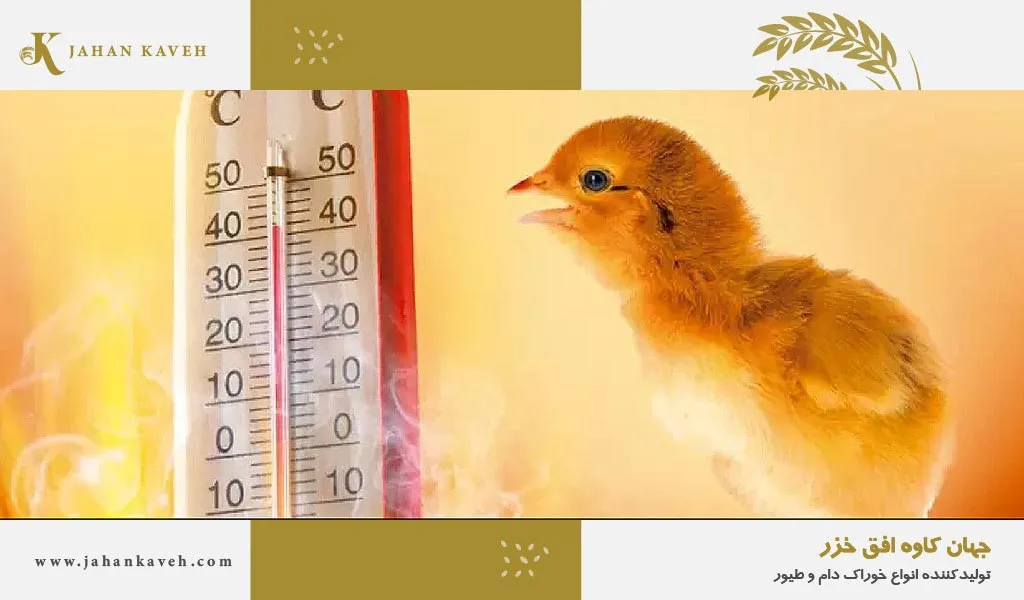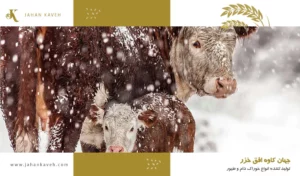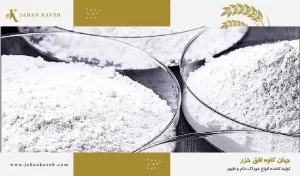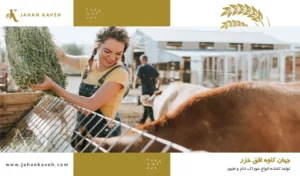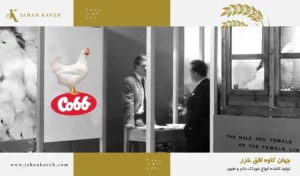How is body heat produced in poultry?
Poultry are warm-blooded creatures, which means they maintain their body temperature at a constant level independently. This process is known as thermoregulation. Thermoregulation in poultry is essential for maintaining vital body functions such as metabolism, digestion, and reproduction. Body heat in poultry is produced through various processes, including:
- Metabolism: The most important source of heat production in the poultry body is metabolism. Metabolic processes such as respiration, digestion, and nutrient absorption are all associated with heat production.
- Muscle activity: All muscle activity in poultry generates heat. Activities such as walking, running, flapping wings, or even shivering, laying eggs, and producing meat. This is why birds increase their metabolism and may shiver more in cold weather to maintain their body temperature.
- Environment: The surrounding environment of the chicken or poultry is another factor that affects body heat production.
In addition, several factors can affect the production of body heat in chickens: - Age: Chicks have a faster metabolism than adult birds because they have a smaller body size and a lower body surface area to weight ratio. This means they produce more heat.
- Breed: The body size and metabolic system of different poultry breeds vary, which affects heat production.
- Sex: In general, roosters have a faster metabolism than hens, so they produce more heat.
- Activity: More active birds produce more heat than less active birds.
- Diet: The diet of birds can affect their metabolism and therefore heat production.
- Ambient temperature: Ambient temperature plays an important role in heat production by birds. In hot weather, birds must work harder to dissipate excess body heat.
How do poultry cool themselves? | How do chicken dissipate body heat?
Since poultry lack sweat glands, which help reduce body temperature, they use other methods to dissipate body heat, which are not always efficient. The mechanisms by which chickens and poultry dissipate heat include:
- Radiation: Radiation occurs when the bird transfers heat from the surface of its skin through the air to another object, including other birds. However, their feather cover limits this flow. High flock density in the hot summer months also becomes a challenge.
- Convection: Birds try to lower their body temperature by creating an air flow over their bodies. Flapping their wings is one of these methods, which increases air flow over their bodies and thus dissipates heat. Chicks also often raise their wings to cool the less feathered skin of their bodies. In fact, they increase the surface area of their bodies exposed to air flow.
- Conduction: Birds dissipate body heat through conduction by transferring heat to cooler objects they are in contact with, such as feeders, slats, or water from sprinklers. This flow does not happen properly for laying hens in cages. Because there are no surfaces in the cage to cool the poultry.
- Evaporation: Poultry dissipate heat by evaporating water from the surface of their skin and respiratory tract. In fact, in this method, chickens increase the rate of evaporation of water from the surface of their respiratory tract by panting, and as a result, dissipate their body heat. However, this method will not be efficient for poultry in a high humidity environment. Because high humidity prevents evaporation.
When the bird’s body temperature reaches 41 degrees Celsius (106 degrees Fahrenheit), heat dissipation processes change significantly. The efficiency of radiation, conduction, and convection mechanisms decreases, and evaporation of water through the respiratory tract through panting becomes the main method of heat dissipation. Evaporating one gram of water removes 540 calories of energy from the poultry’s body.
In addition, the nostrils of birds are responsible for filtering dust and bacteria in the incoming air into the respiratory tract. However, using the respiratory system to dissipate evaporative heat can increase the risk of secondary bacterial infections.
Eventually, if poultry are unable to dissipate excess heat, they experience heat stress, which can have a number of negative consequences.
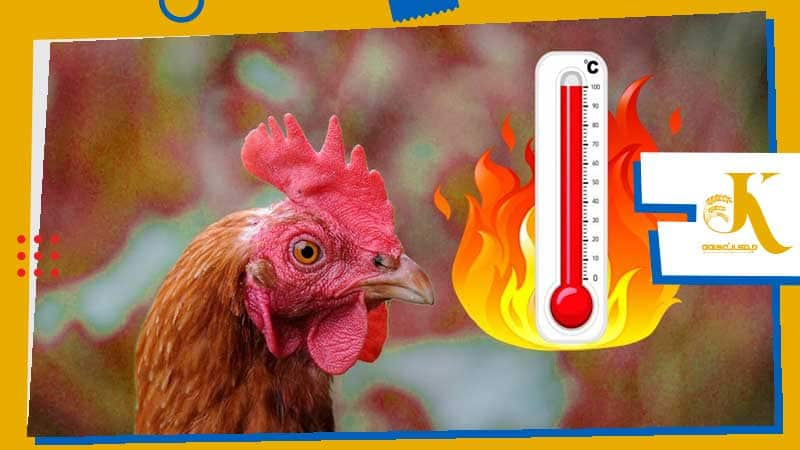
Chicken body temperature
In adult chickens, the temperature range is between 40.6 and 41.7 degrees Celsius, and the body temperature of freshly hatched chicks is about 39.7 degrees. The body temperature of chicks increases from birth and reaches a stable level at 3 weeks of age. The normal body temperature of a healthy chicken is between 41 and 42 degrees Celsius.
To maintain maximum production, the chicken’s body temperature should be around 106 degrees Fahrenheit (41.1 degrees Celsius). Body temperature can be affected by various factors such as sex, breed, age, weight, molting period, broody, and ambient light. In broiler chickens, the “thermal comfort zone” depends on weight, feather cover, shape and distribution of feathers, adaptation, and body water deficit. Increasing the body temperature of a chicken (over 46 degrees Celsius) can be dangerous.
What is poultry heat stress and when does it occur?
As temperatures rise, birds adjust their behavior and feed intake decreases. This temperature change helps to prevent the bird’s body temperature from rising. When the ambient temperature is too high, the bird’s body temperature reaches a lethal level. Heat stress is the result of unsuccessful thermoregulation in the chicken or poultry. This is because the amount of heat absorbed or produced by their body is greater than the heat dissipated.
In fact, poultry heat stress (HS) is the bird’s response to an excessive increase in ambient temperature. Poultry heat stress (HS) occurs when the chicken’s core body temperature is weakened due to heat loss and loses its ability to cope with heat over time. Temperature and humidity play an important role in heat stress. Therefore, it is very important to measure temperature and humidity in the poultry house.
Poultry, particularly one-day chicks, are susceptible to heat stress during transportation. This stress can arise from various factors, including unfavorable transportation conditions and prolonged exposure to incubators. Therefore, adhering to essential guidelines when purchasing one-day chicks is crucial to mitigate heat stress and ensure their well-being.
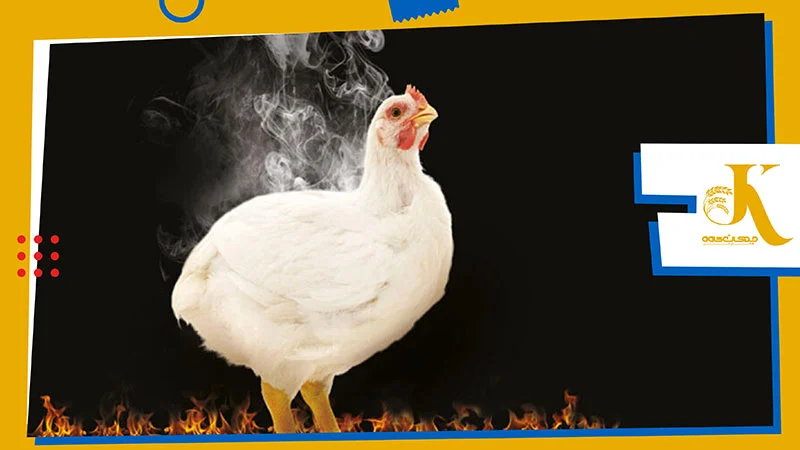
House temperature in poultry farming
The thermoneutral zone is the range of ambient temperature within which an organism can live in comfort. This temperature depends on age and breed, environmental humidity, building conditions, and more. At a neutral temperature, body heat production is minimized. The thermoneutral or optimal temperature for poultry welfare and performance – the so-called thermal zone – is between 18 and 22 degrees Celsius. When birds are kept in this temperature range, they do not have to expend energy to maintain their body temperature.
Excessive heat in poultry, similar to humans, causes discomfort and irritable behavior. This feeling of stress and discomfort leads to aggressive behaviors in birds, which can trigger cannibalism in the flock.
High poultry house humidity and chick heat stress
High humidity in poultry houses makes it difficult for chicks to dissipate heat through respiration and makes them susceptible to heat stress. In other words, at the same temperature, chicks are more susceptible to heat stress in more humid environments.
This is because in humid environments, the air humidity is so high that evaporation from the skin and lungs does not occur effectively. This causes chicks to trap heat in their bodies and experience heat stress
Types of poultry heat stress and ability to adapt to heat stress
This energy imbalance is influenced by environmental factors such as sunlight, heat radiation, air temperature, humidity, and stocking density (number of animals per unit space). Also, factors related to the animal itself, such as body weight, type and distribution of feathers, dehydration status, metabolism, and body thermoregulatory mechanisms, affect this imbalance.
When the ambient temperature exceeds the ideal range, animals activate their thermoregulatory mechanisms to dissipate excess heat. These mechanisms include behavioral changes, biochemical and physiological responses of the body.
Heat stress is divided into two categories: acute and chronic. Acute heat stress refers to a sudden and short-term increase in ambient temperature (within a few hours). While in chronic heat stress, high temperatures persist for longer periods (several days). Some studies show that in some circumstances, poultry can cope to some extent with acute heat stress. However, in the long term, the body’s compensatory mechanisms are not sufficient to maintain health and function, and the bird gets into trouble.
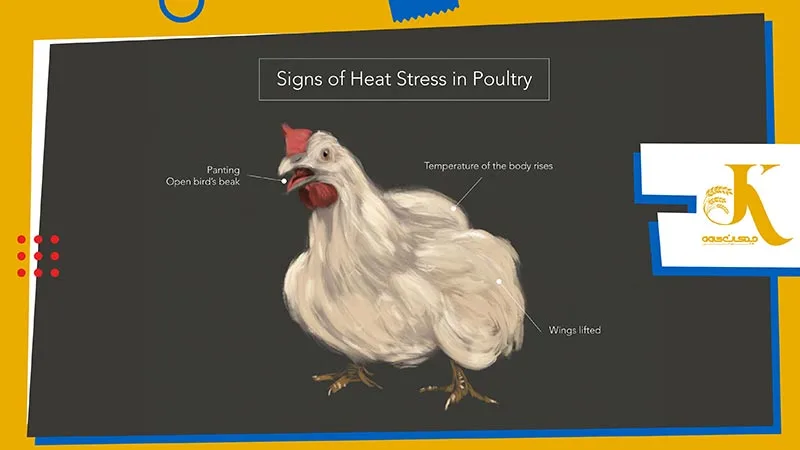
Signs of Heat Stress in Poultry | How to Know if My Chicken or Poultry Farm is Experiencing Heat Stress
As temperatures rise above normal, birds change their behavior to maintain body temperature balance. The bird’s body tries to cool itself by evaporating water through the respiratory tract. Poultry try to lower their body temperature by panting and spreading their wings. Water consumption of birds also increases.
If the environmental conditions do not change and the bird does not find relief, the symptoms worsen and even the entire flock may die. In short, the behaviors and changes observed in birds during heat stress are as follows:
- Reduced social behavior: Birds are less inclined to interact with each other in hot weather.
- Reduced standing: Chickens lie down or sit more in extreme heat.
- Open wings: Birds spread their wings away from their bodies to increase evaporation and dissipate heat.
- Lethargy and sluggishness: Birds are less active in hot weather and may appear lethargic and bored.
- Shaking and confusion: In severe cases of heat stress, birds may experience shaking and confusion.
- Diarrhea: One of the causes of watery diarrhea in chickens is heatstroke. The birds’ droppings become loose and watery in hot weather.
- Decreased appetite: Birds have less desire to eat in extreme heat.
- Increased water intake: Birds drink more water in hot weather to replace lost fluids.
- Panting: Birds initially pant slowly, but in severe cases their breathing becomes rapid and shallow.
- Darkening of skin color: Due to changes in blood circulation in the body, chicks may experience darkening of their skin color in hot weather.
- Seizures: In very severe cases of heat stress, birds may experience seizures.
- Mortality: If no action is taken to combat heat stress, there may be significant losses in the flock.
- Moving away from each other: Chicks move away from each other to cool down and move towards cooler places or cool surfaces like walls.
If you observe signs of heat stress in your flock, you should take immediate action to cool the birds and lower the ambient temperature.
Article: Examining the Different Types of Chicken Poop and Their Causes with Images
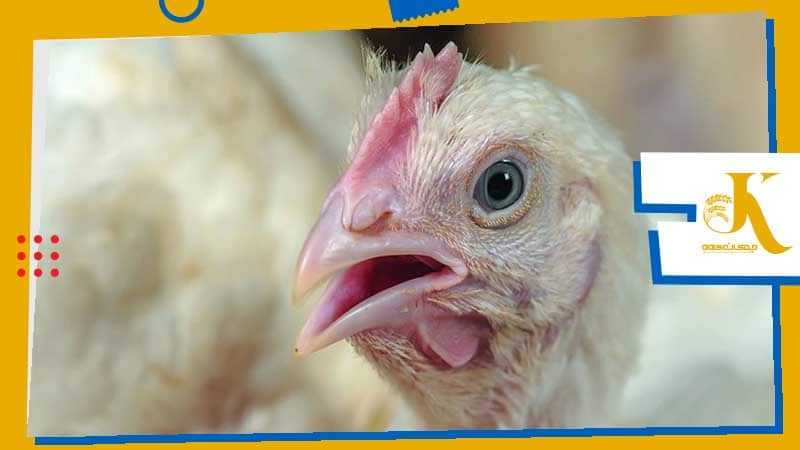
Heat Stress Treatment for Chicks: Immediate Heat Stress Treatment Strategies
Heat stress treatment is most successful when initiated early, before the birds have suffered severe damage. Once a chick’s body temperature reaches 46°C (114.8°F), even with extensive efforts to save the chicks, the mortality rate rises significantly.
The best time to treat chick heat stress is during the initial stages of body temperature increase beyond the thermoneutral zone (the temperature range in which chicks exhibit normal behavior). This prompt intervention can save the chicks’ lives by preventing the situation from escalating further. In the Early Stages of Chick Heat Stress, follow Implement these measures immediately to address chick heat stress:
- Electrolyte and Vitamin Solution: Consult a veterinarian and add an appropriate dose of electrolytes and vitamins to the chicks’ cool drinking water. Repeat this process several times a day until the chicks resume normal feeding. Emphasize the importance of seeking professional guidance for this step.
- Separate Chicks: Divide the birds into smaller groups. Avoid picking them up; instead, encourage them to walk around to help lower their body temperature.
- Remove Access to Grit: For 3 days, deny the chicks access to grit.
- Misting: Mist the housing area to cool down the chicks. Avoid misting the cage tops of laying hens.
- Increase Ventilation: Turn on additional fans to create more airflow and lower the barn temperature.
- Using Cool Water: Utilize ice in the water source connected to poultry drinkers, allowing birds to lower their body temperature by consuming cool water.
Article: Frequently Asked Questions (FAQs) for Poultry Farmers in the Poultry Industry
How long does a poultry farmer have from the onset of heat stress in birds to the start of flock mortality?
A poultry farmer typically has a maximum of 2 to 3 hours .to take action to mitigate the effects of heat stress in their flock. If the flock is not properly monitored and cared for in the initial hours of severe heat stress, it may experience significant mortality within 6 hours .
In addition to the measures outlined in the previous section, it is crucial to closely monitor the flock in the event of heat stress. If no change is observed within an hour and signs of heat stress persist, open windows and doors if available. Otherwise, break a portion of the poultry house wall to allow fresh air to enter. If necessary, guide the birds outside to provide them with fresh air.
Heat Stress Management in Poultry Houses | How to Prevent Heat Stress in Poultry?
When a chicken is exposed to heat stress for an extended period, its body’s mechanisms can no longer cope. As a result, body temperature fails to regulate, leading to increased mortality in the flock due to cardiovascular and respiratory issues .
Several management practices can effectively mitigate the detrimental effects of heat stress. These include:
- Proper ventilation: Ensure adequate air circulation throughout the poultry house.
- Induced darkness: Implement darkness during periods of heat stress to reduce bird activity and metabolic heat production.
- Reduced stocking density: Lower stocking density to minimize heat stress during hot weather.
- Heat acclimatization: Gradually expose birds to increasing temperatures over time to acclimate them to heat.
- Dietary modifications: Adjust the feed to a lower protein and energy density during heat stress periods.
- Sufficient water: Provide ample access to cool, clean drinking water for the birds.
- Monitor for signs of heat stress: Observe birds for signs of heat stress, such as rapid breathing, lethargy, and reduced water intake. Take immediate action to cool the birds and lower the house temperature if such signs are observed.
- Proper ventilation: Utilize cooling systems like coolers and misters, along with effective insulation, to regulate temperature and humidity within the poultry house.
- Utilizing Smart Systems: Artificial intelligence in the poultry industry helps producers improve environmental conditions and animal welfare. Controlling temperature fluctuations and changes using thermometers and sensitive sensors is a very important and necessary task. Data collection systems automatically react when abnormal temperatures occur for poultry, meaning they turn ventilation and air conditioning on or off.
Severe heat can significantly impact poultry health and productivity. Heat stress, induced by elevated environmental temperatures and high humidity, can lead to adverse consequences, including reduced appetite, impaired growth performance, increased mortality, and even death.
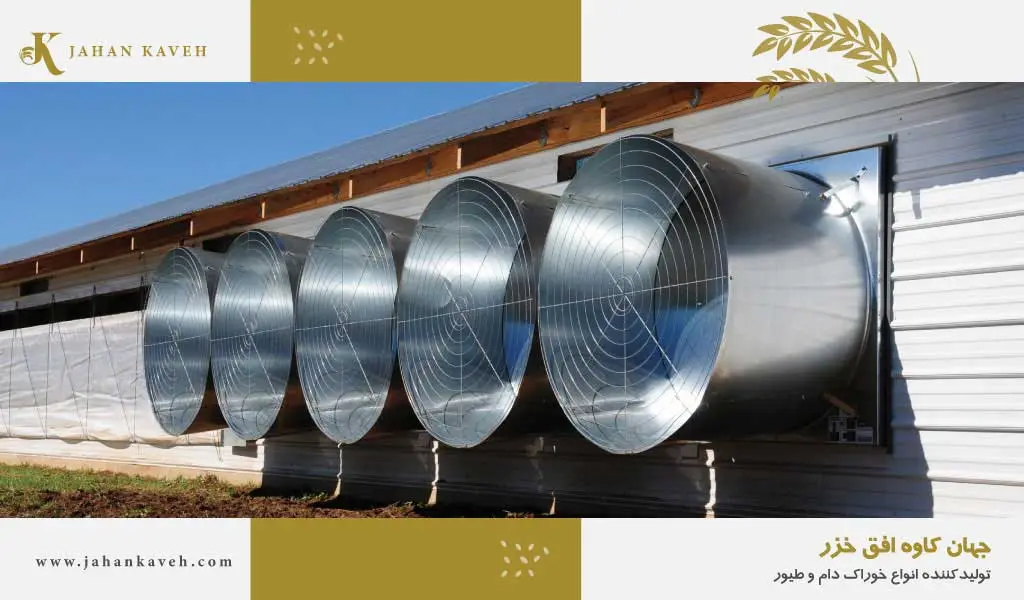
The Crucial Role of Ventilation in Preventing Heat Stress in Chickens and Maintaining Poultry Health
Maintaining a suitable temperature in poultry houses is essential for the health and well-being of birds. During the hot summer months, ventilation plays a critical role in keeping chickens cool and preventing heat stress. In most cases, effectively managing airflow can adequately control flock heat.
Air movement at the bird level is key to removing the heat they generate. When heat intensifies within the poultry house, the primary focus should be on turning on and increasing ventilation to eliminate heat from the birds’ bodies. If the ventilation capacity and airflow in the poultry house are insufficient for the size and number of birds present, the flock will be subjected to heat stress.
Therefore, selecting the appropriate ventilation system based on the geographical region and seasons, and accurately calculating the number of fans required in the poultry house is of paramount importance.
Article: Calculating the Number of Fans in Poultry Houses and Poultry House Ventilation Methods comprehensively addresses the questions of how many ventilation systems and fans should be used in poultry houses and which ventilation system is suitable for poultry houses.
Proper Poultry Nutrition in Summer Heat to Prevent Heat Stress
Appropriate nutrition plays a pivotal role in maintaining poultry health and well-being during the hot summer months. By implementing a suitable feeding program and adopting necessary measures to keep poultry houses cool, heat stress in birds and its detrimental consequences for the flock can be prevented.
The management of production challenges related to heat stress in poultry production can be mitigated by adjusting the poultry feeding program. Major dietary changes in summer should always focus on reducing oxidative stress, maintaining the integrity of epithelial tissues in the digestive tract, and enhancing heat tolerance.
Feedstuffs with lower protein and fat content can be utilized during warm seasons. This helps in reducing metabolic heat production in the birds’ bodies. Additionally, feeds with high levels of vitamins and minerals can be employed to strengthen the immune system of birds against heat stress. Key nutritional changes that poultry producers and nutritionists should consider during the hot summer months include:
- Altered feeding time
- Mineral supplementation
- Provision of clean and cool drinking water
- Electrolyte supplementation in water
- Vitamin supplementation
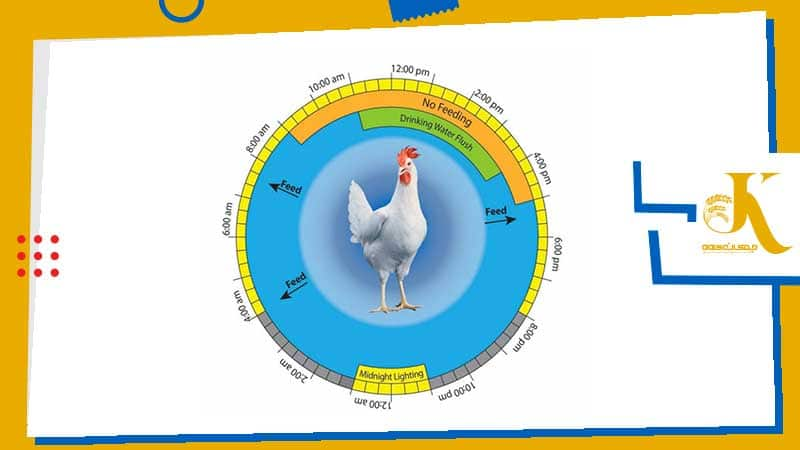
Adjusting Feed Timing in Summer or Hot Seasons to Control Heat Stress
One of the most crucial factors in controlling heat stress in poultry houses is the timing of feed distribution. When birds consume feed, heat is generated due to their body’s metabolic activity. Therefore, it is essential to avoid feeding them during peak heat hours, such as midday, as this can predispose them to heat stress. Hence, it is critical to adjust the feeding schedule for chicks so that they have shed their body heat by the peak heat hours of the day.
Considering that chickens are often hungriest and more inclined to eat their fill in the morning, it is preferable to schedule their feeding during this time. This ensures that the chickens have received their feed before the peak heat hours of the day (usually midday). Then, after some time and passing the peak heat hours (which vary depending on the region and seasons), the next feeding for the chicks can begin.
Additionally, feeding birds during the cooler night hours is also a good practice. Appropriate lighting can be used at night to illuminate the feeders. This helps the birds easily find their food and prevents them from wasting time and energy.
In essence, a chicken’s metabolism increases and raises its body temperature for two to three hours after feeding. Therefore, access to feed should be discontinued at least 4 to 5 hours before peak heat hours.
Consequently, the best time for feeding in poultry houses is from sunset to 9:00 AM at the latest. In line with this, poultry farmers should consider providing full-light periods during the cooler hours of the day (from sunset to sunrise) and reduce lighting inside the house during peak temperature hours.
Article: Broiler Feed Consumption Guide
Mineral Nutrition for Heat Stress Management
Proper mineral nutrition plays a pivotal role in maintaining poultry health and well-being during the hot summer months. By incorporating essential minerals into the poultry feeding program, heat stress can be effectively prevented, and their health and productivity can be maintained during the summer heat. Utilizing high-quality mineral supplements tailored to the specific needs of the flock can effectively achieve this goal.
Certain minerals, such as zinc, manganese, copper, and selenium, can effectively play a role in preventing heat stress and its negative consequences. These minerals act as cofactors for antioxidant enzymes and aid in neutralizing free radicals and protecting cells from oxidative stress-induced damage.
Certain minerals, such as zinc, manganese, copper, and selenium, can effectively play a role in preventing heat stress and its negative consequences. These minerals act as cofactors for antioxidant enzymes and aid in neutralizing free radicals and protecting cells from oxidative stress-induced damage.
Zinc, in particular, plays a crucial role in the function of antioxidant systems and helps protect cells from free radical damage. Additionally, zinc is essential for maintaining the health and function of the digestive system and can help reduce intestinal inflammation and enhance nutrient absorption.
Chromium, on the other hand, can enhance heat tolerance in poultry and aid in maintaining hormonal balance in their bodies. This, in turn, can help reduce anxiety and increase appetite in birds during the summer heat.
Sodium bicarbonate is another beneficial mineral for poultry. The panting or gasping of birds leads to the production of carbon dioxide. This can disrupt their body’s acid-base balance and have detrimental effects on their health and performance. Utilizing sodium bicarbonate in poultry feed can help maintain their acid-base balance. Additional benefits of sodium bicarbonate in poultry feed include:
- Improved respiration: Sodium bicarbonate can help neutralize acid in the body and make breathing easier for birds. This is particularly important during the summer heat when respiration becomes more challenging for birds.
- Enhanced egg quality: Acid-base balance impacts eggshell quality and the contents within. Utilizing sodium bicarbonate can contribute to the production of eggs with stronger shells and better nutritional quality.
- Promoted overall health: Maintaining acid-base balance is essential for overall poultry health. Sodium bicarbonate can help strengthen the immune system, improve digestive function, and enhance disease resistance.
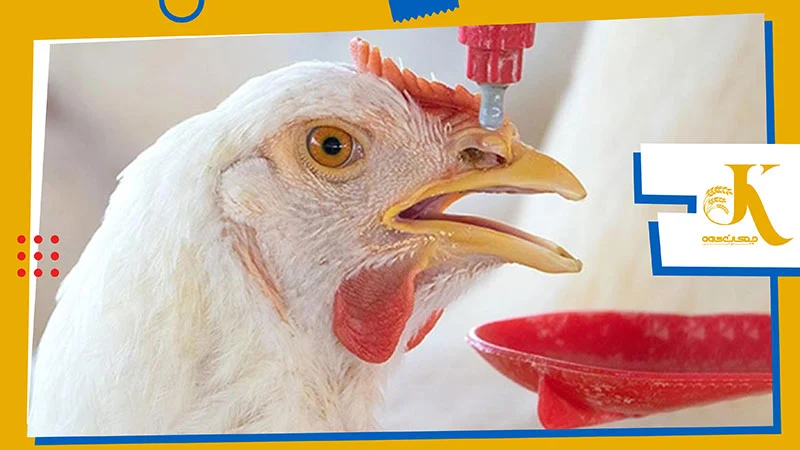
Providing Cool and Ample Water: The Key to Combating Heat Stress in Poultry Houses
Water is essential for the health and vital functions of all living organisms, including chickens. During periods of intense heat, chickens require more water to regulate their body temperature. Therefore, water management in poultry houses is of paramount importance during hot weather.
Under heat stress conditions, chickens can consume 2 to 4 times more water than their usual intake. Hence, it is crucial to ensure that sufficient and cool water is available to the chickens at all hours of the day and night.
The number of waterers should be adequate to allow all chickens easy access. The density of waterers should be such that it prevents overcrowding and competition among chickens for drinking water. Additionally, waterers should be placed in cool and shaded locations. This means positioning them away from heat sources like heaters and direct sunlight.Regular cleaning and disinfection of waterers are essential to prevent the growth of algae and bacteria. Using clean and cool water to fill the waterers is paramount.
Combating Heat Stress in Chicks: The Crucial Role of Electrolytes
Electrolytes are minerals that play vital roles in the bodies of birds. They help maintain fluid balance, regulate nerve and muscle function, and aid in nutrient absorption. During periods of intense heat, chicks lose significant fluids and electrolytes due to increased sweating and respiration. This can lead to electrolyte deficiencies and exacerbate the negative consequences of heat stress.
Heat stress in birds, including broiler chicks, causes the loss of minerals such as potassium, sodium, phosphorus, magnesium, and zinc. Supplementation of electrolytes in chicks’ drinking water can help replenish lost electrolytes and assist in maintaining their health and performance during the summer heat.
Potassium chloride electrolytes, when provided in drinking water at a concentration of 0.6%, appear to increase water intake. In general, the most effective salts are potassium and sodium salts. It is important to note that electrolytes should be administered before the onset of heat stress and strain.
The Crucial Role of Poultry Vitamins in Combating Heat Stress and Promoting Chick Health
Vitamins play a critical role in maintaining the health and function of the immune system in chicks. Vitamin deficiencies can make chicks more susceptible to heat stress and its detrimental effects. Utilizing appropriate vitamin supplements in chicks’ feed can effectively aid in preventing heat stress and promoting chick health and growth.
For instance, vitamins A, D, E, and the B complex contribute to strengthening the immune system, enhancing lung function, and increasing resistance to diseases. Supplementation with these vitamins in broiler chicks’ drinking water can effectively combat heat stress-induced mortality.
Vitamin C for poultry possesses potent antioxidant properties, helping protect cells from free radical damage. In laying hens, vitamin C consumption can aid in reducing body temperature, increasing egg production, and improving eggshell quality. Additionally, vitamin C can modulate and regulate sperm production in breeding males.
Here’s a breakdown of the benefits of specific vitamins for chicks under heat stress:
- Vitamin A: Enhances immune function, promotes growth, and improves vision.
- Vitamin D: Aids in calcium absorption, bone development, and egg production.
- Vitamin E: Acts as an antioxidant, protects cell membranes, and enhances immune response.
- B Vitamins: Support energy metabolism, nerve function, and overall health.
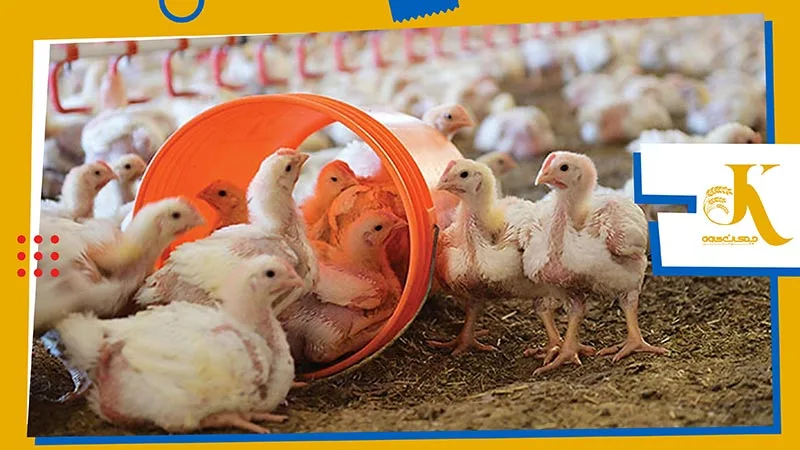
Impact of Heat Stress on Broilers: How Heat Stress Affects Meat Quality
Heat stress (HS) in poultry houses poses significant concerns for poultry producers. One of the detrimental effects of heat stress on broilers is the reduction in growth and meat quality. A major negative impact of heat stress on broiler meat is the decrease in its water-holding capacity. This leads to water loss and moisture depletion in the meat, resulting in reduced freshness, taste, and texture.
Furthermore, impaired protein synthesis and increased undesirable fat adversely affect broiler meat quality. Proteins play a crucial role in muscle structure and function, and their deficiency can lead to weakened and smaller muscles. Studies have also shown that heat stress can negatively impact myogenic regulatory factors. This can have a detrimental effect on the growth and development of the chicks’ skeletal muscles and, consequently, the quality of the meat produced.
In general, the negative impacts and consequences of heat stress in broiler poultry houses include:
- Increased blood pH and disruption of acid-base balance
- Reduced feed intake and slower growth
- Higher mortality rates
- Production of lighter
- carcasses with less fat
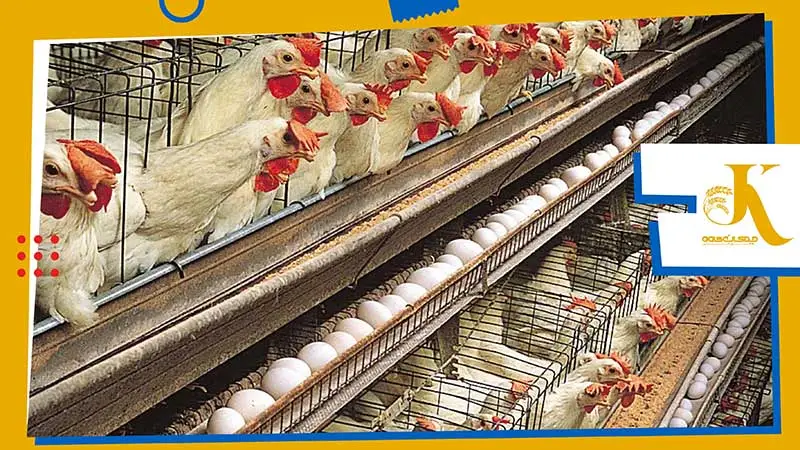
Impact of Heat Stress on Laying Hen Production Performance and Egg Quality
Heat stress can significantly impair the production performance of laying hens and the quality of the eggs they produce. Research has shown that chronic heat stress substantially reduces protein intake in the diets of laying hens. This can lead to deficiencies in essential amino acids, consequently disrupting the birds’ growth, production, and health.
Heat stress can also negatively impact the digestive capacity of laying hens, particularly for lipids and proteins. This can result in incomplete nutrient absorption, leading to reduced production efficiency and increased feed waste.
One of the most notable adverse effects of heat stress on laying hens is the reduction in eggshell quality. Due to panting and carbon dioxide production in laying hens, and the consequent decrease in calcium carbonate, eggshells become thinner and more fragile.
Studies in poultry farming have demonstrated that heat stress in laying hens causes weight loss, reduced egg production, and decreased egg weight. Overall, the negative impacts and consequences of heat stress in laying hen poultry houses include:
- Increased hen mortality
- Reduced laying hen weight
- Decreased egg production
- Diminished egg weight
- Impaired eggshell quality
- Increased production costs
References:

